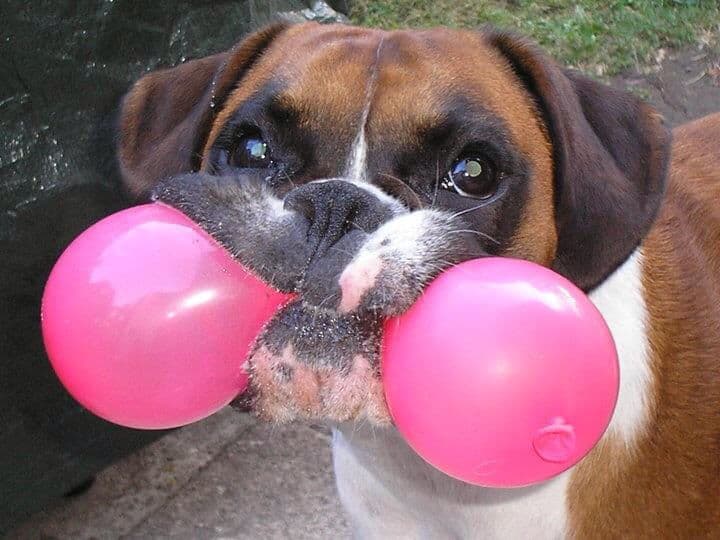Helium can seem like a fun thing to do to your dog, but you should be extremely cautious. While the gas itself is inert and doesn’t directly harm, the effect of what it does can be fatal. Here’s why.
Helium might seem harmless due to its common presence in parties and celebrations, but its effect on a canine’s respiratory system is a concern every dog owner should be aware of.
People have lost consciousness and even died from using Helium too intensely. So if humans can be harmed by it, what about a dog that doesn’t even know the dangers? Let’s dive deeper into this.

Why Helium Isn’t Safe for Dogs
Dogs’ respiratory systems are uniquely designed and are more sensitive than ours, and introducing Helium instead of oxygen could have grave repercussions.
While Helium is not toxic in itself, dogs who breathe helium risk becoming confused, hostile, and possibly hurting their internal organs from a lack of oxygen. This means they could suffocate because of the lack of oxygen and develop fear and aggression toward balloons.
What’s especially sinister about inhaling this gas (He) is that it doesn’t cause a reaction that makes you crave oxygen, as it would if you were breathing carbon dioxide (CO2) instead. You keep breathing Helium while not producing CO2, which can eventually suffocate you due to a lack of oxygen.
Even though they won’t feel like they’re suffocating, the dog may start to lose consciousness. Your dog might not know this and might breathe in Helium independently because they saw you do it.
Does Helium Work on Dogs’ Bark?
Like humans, the pitch depends on how much gas moves through the animal. So, if the dog breathed in Helium, it would bark at a high pitch. Even a pipe organ or flute made of metal could show the pitch difference between normal air and Helium. But it doesn’t mean it’s safe or a dog would like it.
Helium does not affect the physical qualities of the sound source. When sound travels through various mediums, it is slowed down more in denser media, making it sound lower. Technically, it’s not the pitch that changes but the timbre, but we can barely notice this difference.
Because Helium is less dense than normal air, it does not slow sound down as much, the frequency is higher, and the sound is higher-pitched. It makes no difference where the voice comes from (yours, your dog’s, etc.).
So long as you have a sound source (such as a voice box) in a helium-filled container (such as a throat), the effect will be the same. However, this doesn’t mean that it’s not dangerous and potentially a form of animal cruelty to make your dog inhale Helium for your amusement.
While it might sound entertaining to hear your dog bark in a high-pitched tone, the health risks and stress it places on your pet aren’t worth the momentary giggle. Remember, a dog’s bark is one of its primary means of communication, and altering it, even briefly, can be distressing.
Are Helium Balloons Safe for Dogs?
Beyond the helium content, balloons present multiple risks to dogs, from ingestion to trauma.
For starters, balloons are a choking hazard. Dogs constantly put objects in their mouths to explore, and balloons are no exception. Our furry friends look for all sorts of toys and objects to chew on, and that can be dangerous. If your dog likes to chew a lot, consider a KONG toy, instead.

Secondly, balloons may not move properly through the dog’s digestive system, resulting in a colon obstruction. Dogs developing stomach problems from eating objects is nothing new, as many dog owners are aware.
Therefore, balloons are not digestible. If your dog exhibits symptoms of vomiting, tiredness, and diarrhea, it may have swallowed something and is unable to digest it. A blockage can be life-threatening, whether a balloon, a sharpie, or a silly string. If it happens, a trip to the veterinarian is critical.
Furthermore, the noise made by a popped balloon can occasionally cause a dog to become afraid of balloons, making things like birthday parties difficult. Your dog will develop a fear of balloons, which is terrible for dogs and might cause issues for you and your friends. Never leave your dogs alone to play with balloons, and it’s best not to allow them to get too close to them.
By ensuring balloons are kept out of your pet’s reach, you’re not only avoiding potential helium-related hazards but also safeguarding against a host of other balloon-related injuries.
FAQs
Is breathing in Helium toxic to humans?
Helium is inert, but the biggest danger of inhaling Helium is that it is not oxygen, which we need to live. Thus, you will suffocate if you just breathe Helium instead of oxygen. You can die if you do this too frequently or too intensely. Helium can also cause significant damage to your larynx if used excessively.
How long does inhaling Helium last?
The “funny voice” effect only lasts as long as there’s Helium around your vocal cords. Your voice returns to normal as regular air replaces the Helium. This period is usually between 5 to 10 seconds.
Are helium and laughing gas the same thing?
Helium and laughing gas are not the same things. Laughing gas is Nitrous Oxide (N2O), which your dentist mixes with Oxygen (O2) to relax you before drilling. It gives you euphoria and a high, unlike Helium (He), primarily used in balloons and scientific research.
Why do dogs go crazy over balloons?
Your dog could be either excited, afraid of, or loves the balloons. Often, dogs are scared because balloons will pop loudly or produce weird noises when inflating/deflating. The dog could also love the balloon and may want to pop it. Finally, the latex smell may appeal to the dog.
Do dogs enjoy having air blown on them?
Doing it while playing may not harm the dog but will most likely irritate them. I wouldn’t encourage it, though, because you might get bitten if a dog doesn’t like it. It sometimes depends on the dog, and you must get to know the dog before trying something like this.
Alex, a passionate animal lover, has experience in training and understanding animal behavior. As a proud pet parent to two dogs and three cats, he founded AnimalReport.net to share insights from animal experts and expand his knowledge of the animal kingdom.




